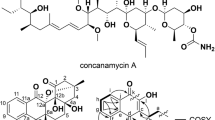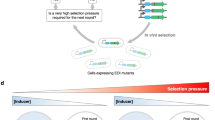Abstract
WE are interested in the evolutionary adaptation of enzymes and their control systems in different environments. We have studied the thermostability of organisms and their enzymes with DNA-mediated transformation between Bacillus spp. using an essential biosynthetic enzyme as a well-defined biochemical marker. Purification and characterisation of the enzyme L-histidinol dehydrogenase (HDH), EC 1.1.1.23, from a range of temperature-adapted species1,12 has shown that although they possess similar physical characteristics, Michaelis constants, molecular weights, subunit numbers and pH optima, they show vastly different temperature ranges of activity. Singleton and Amelunxen2 conclude that present evidence is incompatible with any single theory of the mechanism of thermophily. There seems to be a general finding, however, that the amino acid sequence itself confers thermostability, either through disulphide bridge interaction, by an increased proportion of hydrophobic amino acids, or by an interaction with metallic ions giving an altered conformation.
This is a preview of subscription content, access via your institution
Access options
Subscribe to this journal
Receive 51 print issues and online access
$199.00 per year
only $3.90 per issue
Buy this article
- Purchase on Springer Link
- Instant access to full article PDF
Prices may be subject to local taxes which are calculated during checkout
Similar content being viewed by others
References
Lindsay, J. A., and Creaser, E. H. (in the press).
Singleton, R., and Amelunxen, R. E., Bact. Rev., 37, 320–342 (1973).
Howard, J., 44th ANZAAS Conference, Perth (1973).
McDonald, W. C., Can. J. Microbiol., 15, 1287–1291 (1969).
Watanabe, K., and Oshima, T., FEBS Lett., 43, 59–63 (1974).
Radloff, R., Bauer, W., and Vinograd, J., Proc. natn. Acad. Sci. U.S.A., 57, 1514–1521 (1967).
Spizizen, J., Proc. natn. Acad. Sci. U.S.A., 44, 1072–1078 (1958).
Hotchkiss, R. D., and Gabor, M., A. Rev. Genet., 4, 193–224 (1970).
Marmur, J., Seaman, E., and Levine, J., J. Bact., 85, 461–467 (1963).
Brown, M. E., and Apirion, D., Molec. gen. Genet., 133, 317–327 (1974).
Shaw, C. R., Biochem. Genet., 4, 275–283 (1970).
Lindsay, J. A., Creaser, E. H., and Bentley, K. W., Proc. Aust. biochem. Soc., 7, 16 (1974).
Watson, J. D., Molecular Biology of the Gene, second ed., 427–431 (Benjamin, New York, 1970).
Author information
Authors and Affiliations
Rights and permissions
About this article
Cite this article
LINDSAY, J., CREASER, E. Enzyme thermostability is a transformable property between Bacillus spp.. Nature 255, 650–652 (1975). https://doi.org/10.1038/255650a0
Received:
Accepted:
Issue Date:
DOI: https://doi.org/10.1038/255650a0
This article is cited by
-
Cloning of the cyclomaltodextrinase gene fromBacillus subtilis high-temperature growth transformant H-17
Current Microbiology (1993)
-
Purification and characterization of a thermostable α-glucosidase from aBacillus subtilis high-temperature growth transformant
Current Microbiology (1991)
-
Purification, characterization, and comparison of anα-glucosidase (endo-oligo-1, 4-glucosidase) from the mesophileBacillus subtilis and the obligate thermophileBacillus caldolyticus
Current Microbiology (1991)
-
Characteization of bacterial spores from high-temperature growth transformants ofBacillus subtilis
Current Microbiology (1988)
-
Characteristics and production of thermostable α-amylase
Applied Biochemistry and Biotechnology (1983)
Comments
By submitting a comment you agree to abide by our Terms and Community Guidelines. If you find something abusive or that does not comply with our terms or guidelines please flag it as inappropriate.



